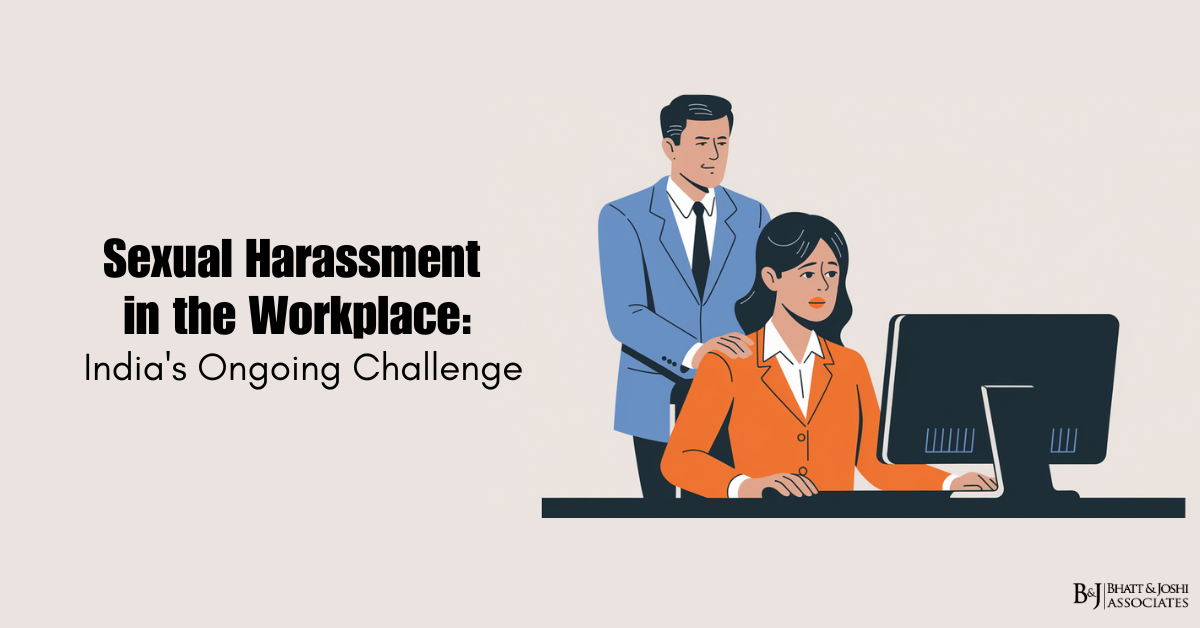Introduction
Sexual harassment in the workplace remains a pervasive and deeply concerning issue in India, affecting millions of women across various sectors and industries. Despite progress in legislation and increased awareness, the problem continues to persist, highlighting the complex interplay of cultural, social, and institutional factors that contribute to its prevalence. This article delves into the multifaceted nature of workplace sexual harassment in India, examining its historical context, current legal framework, societal attitudes, and the challenges faced in implementing effective preventive measures and redressal mechanisms.
Historical Context and Evolution of the Issue
The issue of sexual harassment in Indian workplaces has its roots in deeply entrenched patriarchal norms and gender inequalities that have long characterized Indian society. Historically, women’s participation in the formal workforce was limited, and when they did enter professional spaces, they often faced discrimination, objectification, and various forms of harassment. The struggle against workplace sexual harassment in India gained significant momentum in the 1990s, catalyzed by the infamous Bhanwari Devi case.
Bhanwari Devi, a social worker in Rajasthan, was gang-raped in 1992 as an act of retaliation for her efforts to prevent child marriage in her village. Her pursuit of justice led to a landmark case filed by women’s rights organizations, resulting in the Supreme Court of India’s Vishaka Guidelines in 1997. These guidelines marked a pivotal moment in recognizing sexual harassment as a violation of fundamental rights and laid the groundwork for future legislation.
The Vishaka Guidelines, for the first time, provided a legal definition of sexual harassment and outlined employers’ responsibilities in preventing and addressing such incidents. However, the implementation of these guidelines remained inconsistent and largely ineffective for many years, highlighting the need for more comprehensive legislation and systemic changes.
Legal Framework: The Sexual Harassment of Women at Workplace Act, 2013
Recognizing the limitations of the Vishaka Guidelines and the pressing need for stronger legal measures, the Indian Parliament passed the Sexual Harassment of Women at Workplace (Prevention, Prohibition and Redressal) Act in 2013. This landmark legislation aimed to provide a more robust and comprehensive framework for addressing sexual harassment in all workplaces, both in the organized and unorganized sectors.
Key provisions of the Act include:
- A broader definition of ‘workplace’ that encompasses not only traditional office spaces but also any place visited by an employee during the course of employment, including transportation provided by the employer.
- A more inclusive definition of ’employee’ that covers regular, temporary, ad hoc workers, as well as volunteers and even non-employees such as clients and customers.
- Mandatory formation of Internal Complaints Committees (ICCs) in all organizations with 10 or more employees, and Local Complaints Committees (LCCs) at the district level to address complaints from smaller organizations and the unorganized sector.
- Detailed procedures for filing and investigating complaints, including timelines for resolution and measures to ensure confidentiality and protection against victimization.
- Provision for conciliation if requested by the complainant, but strictly before the inquiry begins.
- Penalties for employers who fail to comply with the provisions of the Act, including monetary fines and potential cancellation of business licenses.
While the Act represented a significant step forward in addressing workplace sexual harassment, its implementation has faced numerous challenges, and its effectiveness continues to be debated.
Current Scenario: Prevalence and Patterns
Despite legislative efforts, sexual harassment remains widespread in Indian workplaces. According to various surveys and studies, a significant percentage of working women in India report experiencing some form of sexual harassment during their careers. The types of harassment range from subtle forms like inappropriate jokes or comments to more overt actions such as unwanted physical contact or demands for sexual favors.
Several patterns emerge when examining the current scenario:
- Underreporting: A large number of cases go unreported due to fear of retaliation, social stigma, lack of faith in the redressal system, or concerns about career implications.
- Power dynamics: Sexual harassment often involves an abuse of power, with perpetrators frequently being in positions of authority over the victims.
- Sector-specific vulnerabilities: While sexual harassment occurs across all sectors, certain industries such as media, entertainment, and the informal sector show higher prevalence rates.
- Intersectionality: Women from marginalized communities, including Dalits, Adivasis, and religious minorities, often face compounded discrimination and are at higher risk of harassment.
- Digital harassment: With the increasing use of technology in workplaces, new forms of harassment have emerged, including cyberstalking, online bullying, and sharing of inappropriate content through digital platforms.
These patterns underscore the complex nature of the problem and the need for multi-faceted approaches to address it effectively.
Societal Attitudes and Cultural Factors
Understanding the persistence of workplace sexual harassment in India requires an examination of the broader societal attitudes and cultural factors that contribute to the problem. Several key aspects come into play:
- Patriarchal mindset: Deep-rooted patriarchal norms continue to influence perceptions of women’s roles in society and the workplace. This often leads to the normalization of certain behaviors that constitute harassment.
- Gender stereotypes: Prevailing stereotypes about appropriate behavior for men and women can create environments where harassment is tacitly accepted or dismissed as “normal” male behavior.
- Victim-blaming culture: There is a tendency in Indian society to blame the victim in cases of sexual harassment, questioning their character, dress, or behavior rather than focusing on the perpetrator’s actions.
- Workplace culture: Many organizations in India still maintain hierarchical structures and male-dominated leadership, which can create environments conducive to harassment and make it difficult for victims to speak out.
- Lack of awareness: Despite increased discussions around sexual harassment, there remains a significant lack of understanding about what constitutes harassment and the rights of employees under the law.
- Social stigma: Victims often face social stigma and potential damage to their reputation if they report harassment, which acts as a significant deterrent to seeking justice.
These societal attitudes and cultural factors create a complex web of challenges that need to be addressed alongside legal and institutional measures to effectively combat workplace sexual harassment.
Challenges in Implementation and Enforcement
While India has made significant strides in establishing a legal framework to address workplace sexual harassment, the implementation and enforcement of these laws face numerous challenges:
- Lack of awareness: Many employees, especially in the unorganized sector, are unaware of their rights under the Sexual Harassment Act. Similarly, many employers are not fully cognizant of their responsibilities in preventing and addressing harassment.
- Inadequate training: There is often a lack of proper training for members of Internal Complaints Committees (ICCs) and Local Complaints Committees (LCCs), leading to inconsistent and sometimes ineffective handling of complaints.
- Fear of retaliation: Despite provisions in the law to protect complainants from victimization, many victims fear professional and personal repercussions if they report harassment.
- Bias and conflict of interest: In some cases, ICCs may not be truly independent, especially when complaints are against senior management or influential individuals within the organization.
- Delays in resolution: Despite stipulated timelines in the Act, many cases face significant delays in investigation and resolution, causing additional stress to the complainants.
- Inadequate penalties: The penalties prescribed under the Act are often viewed as insufficient deterrents, particularly for large organizations or high-profile individuals.
- Limited resources: Many organizations, especially smaller ones, lack the resources to effectively implement all aspects of the law, such as regular training programs and awareness initiatives.
- Challenges in the unorganized sector: The unorganized sector, which employs a large portion of India’s workforce, poses unique challenges in terms of implementation due to its informal nature and lack of structured employer-employee relationships.
Addressing these challenges requires a multi-pronged approach involving government bodies, employers, civil society organizations, and the general public.
Impact on Victims and Workplaces
The consequences of sexual harassment in the workplace extend far beyond the immediate incident, profoundly affecting both the victims and the overall work environment. For victims, the impact can be severe and long-lasting. Many experience significant psychological distress, including anxiety, depression, and post-traumatic stress disorder. This emotional toll often leads to decreased job satisfaction, reduced productivity, and in some cases, resignation from their positions. The career trajectories of victims can be severely disrupted, with some choosing to change industries or even leave the workforce entirely, resulting in financial losses and stunted professional growth.
Physical health is also frequently affected, with victims reporting stress-related ailments such as headaches, gastrointestinal issues, and sleep disturbances. The ripple effects of these health issues further compound the professional challenges faced by victims, creating a vicious cycle of stress and underperformance.
Moreover, the impact of sexual harassment extends to the victim’s personal life, often straining relationships with family and friends. The shame and stigma associated with being a victim of harassment can lead to social isolation and a breakdown of support systems, further exacerbating the psychological impact.
From an organizational perspective, workplace sexual harassment creates a toxic environment that affects all employees, not just the direct victims. It fosters a culture of fear and mistrust, leading to decreased morale and teamwork. Productivity suffers as employees become preoccupied with avoiding potential harassers or navigating uncomfortable situations. The reputation of organizations that fail to address sexual harassment effectively can be severely damaged, leading to difficulties in recruiting and retaining talent, particularly women.
Financial costs to businesses are also significant. These include legal expenses, settlement payouts, increased turnover rates, and lost productivity. In some high-profile cases, the revelation of systemic harassment has led to sharp declines in company value and even bankruptcy, underscoring the severe economic consequences of failing to address this issue.
Role of Technology in Addressing and Perpetuating Harassment
In the digital age, technology plays a dual role in the context of workplace sexual harassment in India. On one hand, it has created new avenues for harassment, while on the other, it offers innovative solutions for prevention and redressal.
The proliferation of digital communication tools has expanded the potential for harassment beyond physical spaces. Cyberbullying, online stalking, and the non-consensual sharing of intimate images have become increasingly common forms of workplace harassment. Social media platforms and messaging apps can be misused to send inappropriate messages or make unwanted advances, blurring the lines between professional and personal spaces. The anonymity offered by some digital platforms can embolden harassers, making it challenging to identify and penalize offenders.
However, technology also presents opportunities for combating sexual harassment. Many organizations in India are now leveraging digital platforms to conduct mandatory sexual harassment training, ensuring wider reach and consistent messaging. Online reporting systems provide a more accessible and potentially less intimidating method for victims to file complaints, especially in cases where the harasser is in a position of authority.
Artificial intelligence and machine learning are being explored as tools to detect patterns of harassment in digital communications, potentially allowing for early intervention. Some companies are experimenting with AI-powered chatbots to provide initial guidance to employees considering filing a complaint, offering a confidential first point of contact.
Moreover, technology has facilitated the growth of support networks and awareness campaigns. Social media movements like #MeToo have played a crucial role in breaking the silence around sexual harassment, encouraging more victims to come forward and sparking public discussions on the issue.
However, it’s important to note that while technology offers promising solutions, it is not a panacea. The effectiveness of technological interventions depends largely on how they are implemented and the overall organizational culture. There are also concerns about privacy and data protection that need to be carefully addressed when using digital tools to monitor and prevent harassment.
Best Practices and Successful Initiatives
Despite the challenges, several organizations and institutions in India have implemented successful initiatives to combat workplace sexual harassment. These best practices offer valuable insights for creating safer and more inclusive work environments.
One key aspect of successful programs is comprehensive and ongoing training. Organizations that go beyond mere compliance and invest in regular, interactive training sessions for all employees have seen positive results. These sessions not only educate staff about what constitutes harassment but also foster a culture of respect and equality. Role-playing exercises and scenario-based discussions have proven particularly effective in helping employees understand the nuances of appropriate workplace behavior.
Some companies have adopted a ‘zero-tolerance’ policy towards sexual harassment, backing it up with swift and visible action against offenders regardless of their position in the organization. This approach sends a strong message about the company’s commitment to maintaining a safe workplace and can significantly boost employee confidence in the redressal system.
Another successful strategy has been the appointment of neutral, external members to Internal Complaints Committees. This practice enhances the credibility of the committee and helps mitigate concerns about bias or conflict of interest. Some organizations have also established multiple channels for reporting harassment, including anonymous hotlines and online platforms, recognizing that different individuals may feel comfortable with different reporting methods.
Proactive engagement with employees through regular surveys and feedback sessions has helped some companies identify potential issues before they escalate. This approach not only helps in preventing harassment but also contributes to overall employee satisfaction and retention.
Several Indian corporations have gone beyond legal requirements by extending their anti-harassment policies to cover all forms of gender-based discrimination and violence. This comprehensive approach acknowledges the interconnected nature of various forms of discrimination and creates a more holistic framework for promoting equality.
In the public sector, some state governments have launched innovative awareness campaigns targeting both formal and informal workplaces. These campaigns use a mix of traditional and digital media to reach a wide audience, including workers in the unorganized sector who are often the most vulnerable to harassment.
Collaboration between companies, NGOs, and legal experts has also yielded positive results. Some organizations have partnered with women’s rights groups to conduct more effective training sessions and to provide support services for victims. Legal firms specializing in workplace issues have been engaged to strengthen internal policies and ensure robust implementation of the law.
The Way Forward: Recommendations for Improvement
While progress has been made in addressing workplace sexual harassment in India, there is still significant room for improvement. A multi-faceted approach involving various stakeholders is necessary to create lasting change.
At the policy level, there is a need for regular review and updating of the Sexual Harassment Act to address emerging challenges, particularly those related to digital harassment. Strengthening the penalties for non-compliance and expanding the scope of the law to explicitly cover new forms of work arrangements, such as the gig economy, could enhance its effectiveness.
The government should also focus on improving the implementation of the law, particularly in the unorganized sector. This could involve setting up more Local Complaints Committees, providing them with adequate resources, and conducting regular audits of their functioning. Initiatives to increase awareness about the law and workers’ rights, especially among vulnerable populations, should be scaled up.
For organizations, creating a culture of respect and equality is crucial. This goes beyond mere compliance with legal requirements and involves a fundamental shift in organizational values and practices. Leadership plays a critical role in this process – when top management consistently demonstrates commitment to preventing harassment and promoting diversity, it sets the tone for the entire organization.
Improving the efficacy of Internal Complaints Committees is another key area. This could involve more rigorous selection processes for committee members, ongoing training and support, and regular evaluation of their performance. Ensuring gender balance and diversity in these committees is also important to build trust and credibility.
The education system has a vital role to play in long-term prevention of sexual harassment. Incorporating modules on gender sensitization, respectful behavior, and workplace ethics in school and college curricula can help shape attitudes from an early age.
Media and entertainment industries, given their significant influence on public opinion, should be encouraged to portray workplace interactions responsibly and avoid normalizing or glorifying behavior that could be construed as harassment.
Civil society organizations and activists should continue their crucial work in advocacy, victim support, and holding institutions accountable. Collaboration between these groups and corporate entities can lead to more effective strategies for prevention and redressal.
Lastly, men must be actively engaged in efforts to combat sexual harassment. Programs that encourage men to be allies and speak out against harassment can be particularly effective in changing workplace cultures.
Conclusion
Sexual harassment in the workplace remains a significant challenge in India, deeply rooted in broader societal issues of gender inequality and power imbalances. While legal frameworks like the Sexual Harassment of Women at Workplace Act have provided a foundation for addressing the problem, their implementation faces numerous hurdles. The persistence of patriarchal attitudes, lack of awareness, fear of retaliation, and inadequate organizational responses continue to hinder progress.
However, the landscape is not without hope. Increased public discourse, successful corporate initiatives, technological innovations, and growing awareness among the younger generation are positive signs. The #MeToo movement has played a crucial role in breaking the silence around sexual harassment and empowering victims to speak out.
Addressing workplace sexual harassment effectively requires a sustained, multi-pronged approach involving government, businesses, educational institutions, media, and civil society. It calls for not just stronger enforcement of laws, but a fundamental shift in societal attitudes towards gender equality and respect in professional spaces.
As India continues to evolve as a global economic power, ensuring safe and equitable workplaces for all is not just a moral imperative but a crucial factor in the country’s socio-economic progress. By fostering environments where all employees can work without fear of harassment, India can unlock the full potential of its diverse workforce, leading to greater innovation, productivity, and overall national development.
The journey towards harassment-free workplaces is ongoing, and while challenges remain, the growing recognition of the issue and the concerted efforts being made across various sectors provide reason for cautious optimism. With continued focus, collaboration, and commitment from all stakeholders, India can aspire to create work environments that are truly safe, respectful, and inclusive for all.














